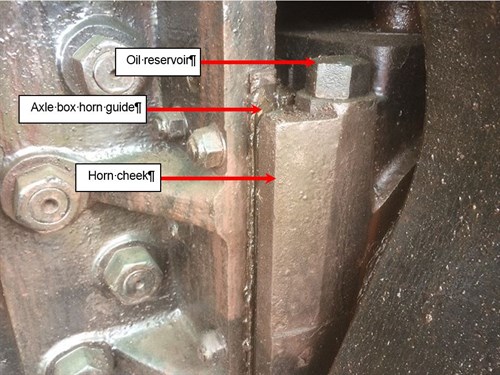What happened
On 9 December 2014, diesel locomotive D2 (Drewry locomotive built 1953, weight 27 t, length 7.6 m) travelled from Regatta Point (Strahan) to Dubbil Barril, to collect an empty passenger carriage for transfer back to Regatta Point. This was in preparation for the recommencement of passenger services between Dubbil Barril and Regatta Point on 15 December 2014. The locomotive and empty carriage, with a crew of three (designated as train 71SG), departed Dubbil Barril at about 1136, bound for Regatta Point.
At about 1215, a radio message was received from the train crew advising that the locomotive had derailed all wheels. The trailing empty passenger carriage remained on track. The crew sustained minor injuries (bruising and stiffness).
What was found
West Coast Wilderness Railway (the operator) investigated the occurrence; the findings of which indicated the track condition and geometry was not a contributing factor. Mechanical examination of the locomotive found that the front right hand axle box horn guide had jammed due to a lack of lubrication (Figure 1). The jammed horn guide had restricted axle articulation while the locomotive was negotiating a slight left-hand curve, causing the leading wheel on the right side to climb the rail head and derail to the right.
A blanket speed restriction of 10 km/h existed for diesel locomotives travelling the section between Regatta Point and Dubbil Barril. Although the locomotive did not have a mechanism to display or record speed, individual crew member interviews and the damage sustained by the track infrastructure and rolling stock suggested that speed was not a factor in the derailment.
West Coast Wilderness Railway operates three diesel locomotives of this type – primarily for shunting and the occasional freight service. They are not normally used for passenger services. Although the locomotives receive regular inspections they can spend long periods idle, are often housed in the open and are subject to the harsh environment of Tasmania’s west coast.
A pre-departure inspection (A-exam) was conducted on the locomotive before operation, but the lack of adequate horn guide lubrication was not noted. The investigation found that the A-exam did not specify a requirement to check the axle box horn guide oil reservoir to ensure lubrication was being applied.
Figure 1: Axle box horn guide

Source: West Coast Wilderness Railway
Safety action
As a result of this occurrence, the West Coast Wilderness Railway has advised the ATSB that they are taking the following proactive safety action in order to reduce their safety risk:
- Review locomotive AB examination recording sheet; making changes where needed and ensuring maintainers are advised of any changes made.
- Review the daily locomotive A-exam to include the need for ensuring the oil reservoir above the axle box horn guide is clear, horn cheeks are showing signs of lubrication and checked for visual signs of binding, and ensure that locomotive crews are advised of the change.
- Investigate the possibility of improving the lubrication delivery method.
- Revisit and amend the risk register for rolling stock inspections.
- Undertake a review of the rolling stock maintenance procedures manual.
ATSB comment
The ATSB noted that the risk exposure for derailment of passenger services is reduced due to the limited use and blanket speed restriction for these types of locomotives on the West Coast Wilderness Railway network. In addition, the ATSB noted that the actions taken by West Coast Wilderness Railway should further reduce the risk of future derailment.
Safety message
This incident highlights to operators and maintainers, the importance of continually monitoring and reassessing risks to the safe operation of rolling stock – particularly with respect to low utilisation operating scenarios.
Purpose of safety investigationsThe objective of a safety investigation is to enhance transport safety. This is done through:
It is not a function of the ATSB to apportion blame or provide a means for determining liability. At the same time, an investigation report must include factual material of sufficient weight to support the analysis and findings. At all times the ATSB endeavours to balance the use of material that could imply adverse comment with the need to properly explain what happened, and why, in a fair and unbiased manner. The ATSB does not investigate for the purpose of taking administrative, regulatory or criminal action. TerminologyAn explanation of terminology used in ATSB investigation reports is available here. This includes terms such as occurrence, contributing factor, other factor that increased risk, and safety issue. Publishing informationReleased in accordance with section 25 of the Transport Safety Investigation Act 2003 Published by: Australian Transport Safety Bureau © Commonwealth of Australia 2015
Ownership of intellectual property rights in this publication Unless otherwise noted, copyright (and any other intellectual property rights, if any) in this report publication is owned by the Commonwealth of Australia. Creative Commons licence With the exception of the Coat of Arms, ATSB logo, and photos and graphics in which a third party holds copyright, this publication is licensed under a Creative Commons Attribution 3.0 Australia licence. Creative Commons Attribution 3.0 Australia Licence is a standard form licence agreement that allows you to copy, distribute, transmit and adapt this publication provided that you attribute the work. The ATSB’s preference is that you attribute this publication (and any material sourced from it) using the following wording: Source: Australian Transport Safety Bureau Copyright in material obtained from other agencies, private individuals or organisations, belongs to those agencies, individuals or organisations. Where you wish to use their material, you will need to contact them directly. |
________________________
A limited-scope, fact-gathering investigation into this occurrence was conducted in order to produce this short summary report and allow for greater industry awareness of potential safety issues and possible safety actions.


